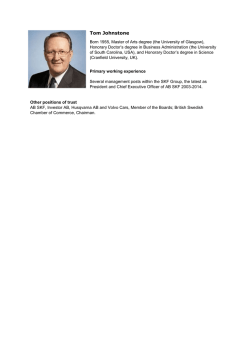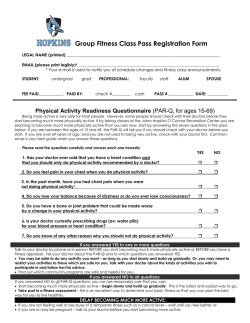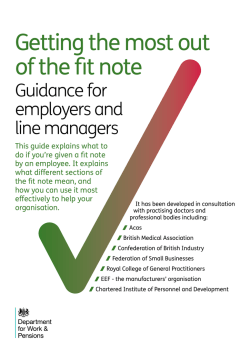
Lida Bitrou- Introduction to the theory and practice of Balint groups
1 Bitrou, L. (2014, November). Introduction to the theory and practice of Balint groups. Paper presented at the proceedings of the 2nd Interdisciplinary Conference of Psychiatry and Related Sciences, Athens, Greece Let me begin my introduction by saying that the doctor-patient relationship, which is the focus of Balint groups, has been fairly different in Greece than in the countries where the Balint method developed over the past six decades. Traditionally, in the Greek society, the doctor was seen as a distinguished power-figure who was highly respected by patients and fellow-citizens, rarely doubted, criticized or challenged by non-doctors. His place in the doctor-patient interaction has been clearly superior to that of the patient and this hierarchy determined the way in which doctor and patient related to one another. As a consequence, the Greek doctor was “immune” for quite some time from circumstances that would put him in a place of selfreflection and self-awareness regarding the way his personality and behavior affected his medical practice and his patients. Patients on the other hand, were mostly ignorant about medical issues, often afraid to ask questions or make any demands, and unconsciously or consciously expecting the doctor to be superior, authoritarian and unapproachable. However, both parties seemed settled in this arrangement in which the patient took the role of a “compliant child” who executed doctors’ orders without any objections, while the doctor took the role of the parent who knew best, and therefore didn’t need, or even want to make the patient an active collaborator in his treatment. At the same time, the “old-fashioned” doctor took his role in society quite seriously as a responsible caregiver and health educator. He developed close bonds with his patients whom he treated in a more holistic way that took into account their personality and individual needs. This of course, was more pronounced in some medical specialties than in others. For example, the pediatrician or the pathologist (who was the equivalent of the GP in the old days in Greece) developed closer relationships with his patients for whom he was responsible for a big part of their lives or during their childhood and adolescence. The same was true about the gynecologist who often treated two generations of women within the same family. This bond that developed between the doctor and the patient, made it easier for the doctor to see the patient as a whole person, and not just a sum of symptoms to which he would apply the appropriate treatment, make the symptoms or the disease disappear and move on to the next patient, almost forgetting the previous one ever existed. 2 This type of doctor, who established long-term therapeutic and humane relationships with his patients, resembles a lot to the general practitioner (also referred to as GP) of the British National Health System, for whom Michael Balint psychiatrist, psychoanalyst and son of a general practitioner himself- created in the 1950s the first groups that took his name. In Great Britain, the health system was based, since its establishment in 1948, on the function of the GP or family doctor, who was responsible for the health of the community and acted as gate-keeper to the rest of the NHS, referring patients where appropriate to hospitals or specialist treatment, and prescribing medicines. In this health system, the patient had his doctor as a collaborator and guide, and, therefore, wasn’t left alone to deal with his illness or symptoms, trying to figure out which specialist he must go to, what medical exams to take or which hospital to choose, as it was the case in Greece or other countries where the GP was never established in primary care. There, everything passed through the GP who was responsible for the patient, often throughout his life. Furthermore, the GP would educate the patient and encourage his involvement in his own care. This way the patient would become an active contributor in the safeguarding of his health or his treatment, instead of being a simple executor of doctor’s orders, as we saw in the previous model of doctor-patient relationship with which we are probably more familiar. This kind of doctor, who was trained to treat many different conditions of the human body, was responsible for the whole patient and not just one of his systems or some of his organs. This, in itself, constituted the basis of an integrative health model on which Balint would develop his views on psychosomatic medicine and his “patient-centered approach”, of which he was the first proponent. Also, in this context, it was quite common for patients to complain to their doctor not only about physical symptoms, but also problems of psychological nature, psychosomatic symptoms or conditions that masked psychological problems, requesting from the doctor to be not just a physician but also a psychologist. How difficult the work of a GP one might say and that was what Balint must have thought, when he decided with his wife Enid, social worker and psychoanalyst, to start in Tavistock Clinic in London, their famous in many countries, research-cumtraining seminars for GPs, also known as Balint groups. At that time, after the World War II and with the NHS in its beginnings, many GPs often expressed dissatisfaction from their work and were under a lot of burden due to an overload of patients, some of whom presented symptoms that didn’t have an organic etiology and left the doctor puzzled and incapable to help. In this context, the Balints wanted to better understand the doctors’ discomfort and see how they could help them. The groups that they formed consisted of eight to twelve doctors and one or two psychoanalytic leaders. They met every week for two hours and the 3 groups went on for a minimum period of two years. Their original aim was to study the difficulties of general practice and find out the reasons why some patients didn’t get well as they should, causing headaches to their doctors. As Enid Balint wrote, “The groups studied in detail what a general practitioner told the group about a patient with whom he was having difficulty, giving special attention to the relationship between the doctor and his patient, often at one particular consultation. We discussed human relationships: not in general terms but one particular relationship at one particular time”. In the beginning the doctor used notes from the consultation with his patient, but later on the Balints adopted the method of supervision used at the Hungarian Psychoanalytical Society which was familiar to Michael Balint from his psychoanalytic training. This was to encourage participants to speak freely without notes, contradict themselves if necessary, have second thoughts, remember things they thought they had forgotten, so that a complete picture with the feelings of the doctor himself emerged about the facts he was reporting. This method of free-association is the one that we use today in Balint groups. The aim of understanding difficult or puzzling patients, or those who don’t get better despite the doctor’s or the therapist’s effort, is still the main task of a Balint group. The seminars in Tavistock clinic continued for twenty years and were carried on by his wife after Balint’s death. Their work with the groups was first published in 1957 in Balint’s famous and widely read book that was translated in many languages, “The doctor, his patient and the illness”. In this book, he develops his ideas on the psychological aspects of general practice and the doctor-patient relationship, the problems that the doctor usually encounters, and the group training that can enable him to deal effectively with problems that derive from or affect the doctor’s relationship with his patients. All these conceptualizations are accompanied in the book by cases of patients that the doctors presented in the group which demonstrate the clinical validity of his theoretical developments. Balint’s conceptualization regarding the doctor-patient relationship, which derived from his work with the groups, developed around this basic idea about the crucial role of the doctor in the outcome of any treatment and was resumed in his famous dictum “the doctor as drug”. He also spoke about what he called “the apostolic function of the doctor” which describes the doctor’s personal set of beliefs and preconceptions about how patients should behave and interact with him, which often makes the doctor overlook the personal psychological traits and individual circumstances of the patient in a “one-size-feets-all” philosophy. The mismatches 4 and misunderstandings that often occur in the doctor-patient interaction usually originate from the “basic fault”, as he called it, of each member of the relationship, a psychoanalytic concept that he later developed in his book entitled “The Basic fault”. This concept describes the fundamental deficits of the personality of an individual caused by the inability of the environment to meet his early-life needs, which later interfere in the doctor-patient relationship and are related to the somatization that many patients present. The doctor, according to Balint, must pay attention and try to control these difficult and often unconscious aspects of his interaction with the patient, as he must also make a “deeper or overall diagnosis” of the patient that goes beyond the medical symptoms, to include the psychological traits and environmental factors that determine the patient’s attitude towards his illness. Only then will the two parties be able to establish a therapeutic partnership in what Balint called the “mutual investment company” which can be defined as the psychological investment of the doctor and the patient in each other over a long period of time. This way the socalled “collusion of anonymity”, which results from the patient’s bouncing from one doctor to another with no one really taking responsibility for him, can be prevented and the patient can benefit from a stable and substantial relationship with his doctor. As you may remember, the groups were originally called “training-cum-research” seminars. We already saw their role in Balint’s research on the dynamics of doctorpatient relationship. But what about the training part? This was relevant to the practical value of the group work for the participants. Because Balint, didn’t just want to “use” the doctors in order to draw conclusions about the particularities and psychological patterns that characterize the doctor-patient interaction. He wanted to help them to better understand their patients and become more efficient in their work. Therefore, he believed that GPs could benefit from the learning of some psychotherapeutic skills that they could apply afterwards in their medical practice, and especially with those patients who presented psychosomatic symptoms or psychological problems. However, this learning was by far different from the kind of learning that the doctors were used to from their training in medical school or the hospital, as it didn’t involve actual teaching and wasn’t based on a teacher-pupil relationship. Instead, it was a training that was based on the personal experience that the doctor acquired through his participation in the group. It should be reminded, at this point, that Balint was a psychoanalyst. And the most important part of a psychoanalyst’s training is his personal psychoanalysis. During his analysis, the future psychoanalyst has the opportunity to become more self-aware about his short-comings and blind-spots - 5 and hopefully improve them- and put himself in the place of the patient, see what it feels like to be one and how a patient sees his analyst. Similarly, in the group, the doctor presents his patient in a free and spontaneous way and then allows to the rest of the group to think freely and talk about his case, while he listens without being able to intervene for a while. This way, he can focus on what his colleagues think about his patient and his own handling of the patient. He can also re-listen to himself through the repetition of his words by the other members, and the impact that his narrative had on the group, the thoughts it brought out and the feelings it arose in them. This process helps the doctor to examine both his patient and himself from a different point of view and from a distance, sometimes identifying with the patient and feeling empathy for him, other times identifying with himself and justifying the negative feelings he has for the patient, and often realizing that both he and the patient had their reasons for reaching an impasse in their therapeutic relationship. And even though one cannot claim that the doctor will become an expert in psychotherapy just from participating in a Balint group, there can be a substantial change in a way he thinks about himself and his patients, after participating in such a group for some time. After looking at what a Balint group has to offer, one could say “Yes but would these groups be useful in a health system that is different from the NHS? A system in which specialists and not GPs are mainly responsible for the treatment of patients and most of the times in the absence of a formal context that clearly defines the doctorpatient interaction and the obligations and rights of each party”? My answer would be “Definitely”. In fact, Balint groups are even more necessary in systems like ours that lack a consistent frame of work and a culture of doctor-patient interaction. In these cases, the group can provide a frame to the doctor-participant and function as a substitute for what the system, the medical school or the hospital cannot provide both in terms of emotional support and psychological training for the doctor. Moreover, every doctor needs to have some psychological skills. Some doctors are gifted in this area but those are probably the minority. Most of us have to be trained in order to be good at something even if we are talented in our work. The same applies to doctors regarding their ability to treat the psychological needs of their patients in a subtle and informed manner. And since everyday medical practice, especially in hospitals, is usually very intense, frenetic and often overwhelming for the doctor, his psychological skills have to be so well-established so that they come almost as a reflex reaction to an emotionally charged situation. And this can only be accomplished through training. At the same time, many specialists are in great need of psychological support for themselves and their patients. Oncologists, neurologists, gynecologists -especially those who specialize in assisted reproductive technologies- and psychiatrists, are 6 only some of the specialists that can benefit from Balint groups as their clinical work has a great deal of psychological burden. Sometimes the burden comes from the patient but other times it comes from the doctor himself who doesn’t know how to deal with the feelings that the patient arouses in him. He then becomes overwhelmed, defensive or aggressive, depending on his personality, depressed or disappointed with his profession. The participation of these doctors in a Balint group provides them with a context of solidarity and sharing, and, in that sense, I think that the group can function as a therapeutic setting for the doctor as it alleviates the frustration, loneliness and anxiety that are very common in the health professions. And of course Balint groups will always have a place for general practitioners who are historically linked with the method and have the privilege of treating their patients for a long time and in a more holistic way than most doctors. For that is seems only fair to close with the words of a GP and long-time Balint group member, Dr Jonathon Tomlinson, who writes in his blog entitled “A better NHS”: “We are trained in detachment and objectivity, and are afraid of intimacy. We are afraid of our patients being dependent on us, or becoming dependent ourselves on our patients. We are afraid of crossing professional boundaries, of becoming overinvolved, of being paternalistic or meddling. Part of this fear is a fear of vulnerability and a denial that as social beings, we actually do depend on each other. If it is hard for us doctors to come to terms with actually hating our patients, it is even harder to admit that we need our patients to love, respect, care about and depend on us”. References Balint, M. (1957). The doctor, his patient and the illness. London: Pitman Medical. 2nd edition (1964, reprinted 1986) Edinburgh: Churchill Livingstone Tomlinson, J. (2012, December 5). Love, hate and commitment. Retrieved from https://abetternhs.wordpress.com/2012/12/05/love
© Copyright 2024







